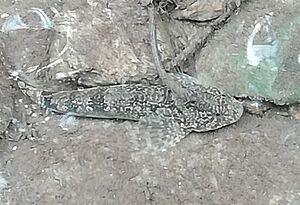Alpine bullhead facts for kids
Quick facts for kids Alpine bullhead |
|
|---|---|
 |
|
| Conservation status | |
| Scientific classification | |
| Synonyms | |
|
The alpine bullhead (also known as the Siberian bullhead) is a type of freshwater fish. It belongs to a group of fish called sculpins. You can find this fish in many countries. These include China, Germany, Poland, Russia, and Sweden. The IUCN says this fish is "Least Concern". This means it is not currently in danger.
What Does the Alpine Bullhead Look Like?
The alpine bullhead has a big, wide head. Its body gets thinner towards its tail. It has large fins and a round tail. This fish is usually light brown. It has darker spots or patches all over its body. Its eyes are placed near the top of its head.
This fish looks a lot like the European bullhead. They can even live in the same streams. You can tell them apart by looking at their pelvic fins. The alpine bullhead's inner pelvic fin ray is shorter than the outer one. The European bullhead's rays are about the same length.
The alpine bullhead's pelvic fins also have dark spots. These spots make the fins look striped when they are close together. The European bullhead's fins are clear. When the alpine bullhead rests on the bottom, its pectoral fins spread out. They look a bit like wings. This fish is usually about 5 to 8 centimeters (2 to 3 inches) long. The biggest ones can grow up to 12 centimeters (about 5 inches).
Where Do Alpine Bullheads Live?
The alpine bullhead lives in northern and central Europe. It prefers cold water. You can find it in streams and lakes in mountain areas. It also lives in upland regions.
How Do Alpine Bullheads Live?
The alpine bullhead eats small creatures. It finds its food on the bottom of streams. Its diet includes insects, tiny crustaceans, and other small invertebrates. This fish is usually active at night. But in the Arctic during winter, it becomes active during the day.
In spring, when the water gets warmer (around 5°C or 41°F), the males get ready to breed. A male will make a nest under a large stone. Several females will then lay their eggs in this nest. The male then guards the eggs. He protects them for about a month until they hatch.


